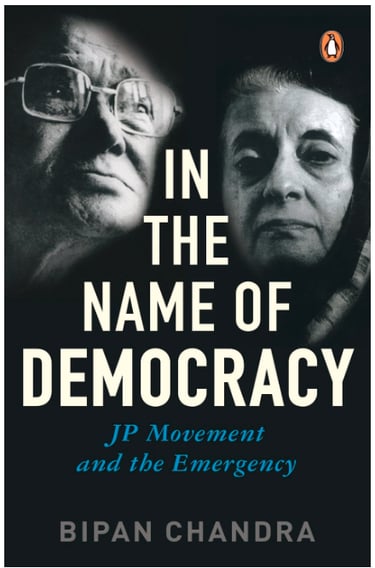National Emergency of 1975
The National Emergency of 1975 is a significant event in the democratic polity of India. In this post we shall cover the various aspects related to the National Emergency declared in 1975.
INDIAN POLITY
The Emergency of 1975 in India is one of the most critical and controversial chapters in the country's political history. Imposed by then Prime Minister Indira Gandhi, it lasted from June 25, 1975, to March 21, 1977. This period witnessed the suspension of democratic processes, and fundamental rights, and had long-lasting implications for Indian politics. Civil service aspirants need to understand its causes, events, and consequences deeply, as it forms an essential part of modern Indian political history.
Background
By the mid-1970s, Indira Gandhi's government faced several political, social, and economic challenges. These included rising inflation, unemployment, food scarcity, and nationwide strikes by trade unions and student movements. The popular discontent culminated in the Bihar and Gujarat movements, led by student groups and leaders like Jayaprakash Narayan (JP), which demanded reforms and an end to corruption in public life.
The situation escalated when, on June 12, 1975, the Allahabad High Court declared Indira Gandhi's 1971 election to the Lok Sabha invalid on grounds of electoral malpractice. The court's judgment disqualified her from holding public office for six years. This decision severely threatened her political position, but instead of resigning, she moved the Supreme Court, which granted her a conditional stay on the order. Meanwhile, political opposition and demands for her resignation intensified.
Proclamation of Emergency
On June 25, 1975, Indira Gandhi advised President Fakhruddin Ali Ahmed to declare a state of internal emergency under Article 352 of the Constitution. The official justification was the threat to national security, citing internal disturbances, but the move was largely seen as a means for Gandhi to consolidate her power and suppress the growing opposition.
With the declaration of the Emergency, civil liberties were suspended, censorship of the press was imposed, political opponents were arrested, and strikes were banned. Prominent opposition leaders, including Jayaprakash Narayan, Morarji Desai, Atal Bihari Vajpayee, and many others, were imprisoned without trial under the Maintenance of Internal Security Act (MISA).
Key Features of the Emergency
1. Suspension of Fundamental Rights: The Emergency allowed the central government to curtail civil liberties, including freedom of speech, freedom of assembly, and the right to move the courts for the enforcement of fundamental rights. Articles 19 and 21 were effectively suspended.
2. Press Censorship: The press was heavily censored, and many newspapers were shut down or forced to publish government-approved content. Journalists critical of the government were harassed, and media outlets had to submit content for government scrutiny.
3. Arbitrary Arrests: Thousands of opposition leaders, activists, and dissidents were arrested under preventive detention laws. Many were held without trial, and the judiciary's role in protecting individual liberties was weakened.
4. Forced Sterilization Campaign: One of the most controversial actions during the Emergency was the family planning program led by Indira Gandhi's younger son, Sanjay Gandhi. Under this program, mass sterilizations were carried out, often forcibly, in a bid to control the population. This resulted in widespread public resentment, especially among the poor.
5. Constitutional Amendments: Several constitutional amendments were passed to strengthen the central government's powers during the Emergency. The most notable was the 42nd Amendment, often called the "Mini-Constitution," which made significant changes to the balance of power between the judiciary and the executive and curtailed judicial review.
Consequences of Emergency
1. Erosion of Democratic Institutions: The Emergency led to a severe weakening of democratic institutions. The centralization of power, especially in the Prime Minister's Office, undermined the checks and balances in the political system.
2. Public Backlash: Despite the government's efforts to suppress dissent, public resentment grew due to the autocratic measures, including censorship, forced sterilizations, and the absence of political freedoms. The Emergency became increasingly unpopular, and Indira Gandhi’s popularity declined sharply.
3. Restoration of Democracy: In January 1977, under mounting pressure both domestically and internationally, Indira Gandhi announced elections for March of the same year. In a surprising move, the Emergency was lifted, and normal democratic processes were restored. In the general election, Gandhi and the Congress Party suffered a crushing defeat, with the Janata Party forming the government under Prime Minister Morarji Desai, marking the first time the Congress lost power at the center.
4. Impact on Indian Politics: The Emergency had a lasting impact on Indian politics. It intensified the debate on the nature of executive power, judicial independence, and the limits of constitutional governance. The judiciary later restored many of the rights curtailed during the Emergency, and subsequent amendments to the Constitution, such as the 44th Amendment, were introduced to prevent the misuse of emergency provisions in the future.
Lessons from the Emergency
1. Vigilance for Civil Liberties: The Emergency serves as a reminder of the need for constant vigilance in protecting civil liberties and democratic institutions. The concentration of power in the executive and the suppression of dissent can have far-reaching consequences for democracy.
2. Role of the Judiciary: The Emergency exposed the vulnerability of the judiciary during periods of executive overreach. It underscored the importance of judicial independence in maintaining the balance of power.
3. Importance of Political Accountability: The popular backlash against the Emergency demonstrated the critical importance of political accountability in a democracy. The electorate’s rejection of authoritarian rule in the 1977 elections reaffirmed the strength of democratic values in India.
Conclusion
The Emergency of 1975 remains a defining moment in India’s political history. It revealed the fragility of democratic systems in the face of concentrated power but also the resilience of India's democratic ethos. For civil service aspirants, understanding the Emergency provides key insights into the functioning of constitutional governance, the importance of safeguarding democratic rights, and the role of political leadership in maintaining the balance between authority and liberty.



